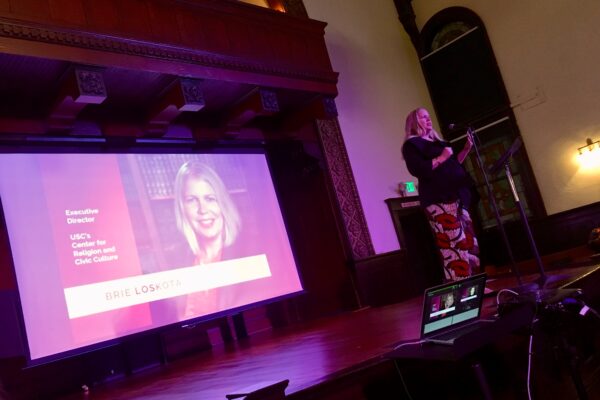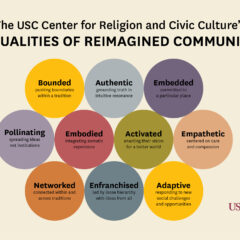The following is a speech given at The Collaboratory, a gathering of Jewish leaders.
When I was teaching at a Jewish day school for girls, one of my students approached me excited about a celebrity siting. She pulled out her camera and showed me a picture of her hugging Bradley Cooper with great excitement on her face, clearly thrilled to have met such a handsome Hollywood a-lister.
“Honey, aren’t you shomer negiah?” I asked, referring to the Orthodox practice of women and men not touching each other outside of one’s immediate family.
“Yes, but not for celebrities,” she responded.
This moment was a lesson in how religion and religious people are remarkably adaptive. Los Angeles is a place where we see adaptation happening all the time, not only because many girls as well as some guys would like to give a full-body hug to Bradley Cooper, but because of the unique attributes of L.A. itself.
In order to understand innovation, we first need to define it. My center, the Center for Religion and Civic Culture at USC, undertook a multi-year project to explore how religions are changing and where there is creativity in religious environments across Greater Los Angeles and Seoul, South Korea. That attention to the phenomenon of religious change is especially important in this time of organizational and cultural flux—period of rapid and continuous evolution, where the old order is being torn down, where people are disaffiliating from religious groups, and where congregational life is being stressed and stretched. Is it just a period of destruction, or is there more going on?
To reach the answer to this question, we puzzled over the definition of innovation. Many people think about innovation as some form of newness. But when it comes to religion and other movements in the social sector, I’m not sure much is new (the Bible perhaps has something to say about that).
By innovation, we don’t mean creating something entirely new or a new form of revelation. While new religious movements are created, that is rare. We mean the reassembling of different elements of religion and spirituality to meet contemporary challenges. We see innovation as the adaptive repurposing, rediscovering, recombining of what already exists. Sometimes that entails bringing those elements from one group into another and infusing them with new meaning and relevance. It also means being open to trying out something other than what has always been done, even if doing so means pushing the boundaries of the acceptable current orthodoxy.
As one of our interviewees noted, innovation is a form of creative problem solving.
What do you need for this type of innovation? You need density—you need a lot of things in one space bumping into, stumbling over, and existing next to each other. That’s why L.A. is such an amazing place for religious innovation. As our mayor likes to say, L.A. is the most religiously diverse experiment in all of human history.
Religion has always coursed through the veins of the City of Angels. The sacred spiritual sites of the area’s earliest settlers, the Tongva people, are still threaded through L.A. The earliest European settlements were anchored by religion, with the founding of the San Gabriel Mission by Franciscan monks in 1771.
And spiritually fervent Angelenos have also been remarkably innovative. American Pentecostalism was born L.A. in 1906 in a small interracial church on Azusa Street in what is now Little Tokyo. Paramahansa Yogananda founded the Self-Realization Fellowship here in 1920 and taught Kriya Yoga long before yoga pants became the uniform of suburban leisure.
It’s also important to realize that this rich religious landscape is in constant motion. Some spiritual groups cross-pollinate across traditions, and all of these groups create layers of history as they rise or fall, move up or move on, and move in or move out of buildings and neighborhoods.
Sephardic Temple Tifereth Israel was a Jewish congregation founded 100 years ago on what is now Martin Luther King, Jr. Blvd. Currently it is Greater New Vision Missionary Baptist Church, an African-American church surrounded by an increasingly Latino neighborhood.
And this place, the Pico-Union Project, was a synagogue built in 1909 and eventually acquired by the Welsh Presbyterian Church, only to be bought once again by a Jewish organization and rehabbed as a center for Jewish spirituality, interfaith engagement and the arts.
That’s how you get a Sikh langar—a kitchen out of which a congregation serves free meals to the poor—morphing into a food truck that sells Punjabi burritos in a Tom’s Shoes charity model (buy a burrito, and in doing so you’re also paying for the meal of someone who might otherwise go hungry).
This is an on-the-ground example of how L.A.’s dense and diverse range of religious elements mix together. The bold risks of the langar food truck were theological, counter-orthodox: Can a langar hall be on a food truck and not in a gurdwara, a Sikh house of worship? Would a business model not built on donations be acceptable? Would enough people, both Sikh and non-Sikh, want to serve as volunteers to make the burritos and distribute them on Skid Row and other homeless enclaves?
Fortunately, all the risks paid off. In fact, the group hardly felt like they were undertaking something risky, mostly because they framed their work around a few questions: What can we do with what we have to make a difference where we are? Who will benefit and what will we learn? What do we want to discover about ourselves?
That, to me, feels like an especially L.A. question, and a very L.A. type of innovation. In my center, we contrast two different types of innovation: the resource-rich, Silicon Valley-style innovation that finds bright people with big, bold ideas and gives them lots of space, and resources, and ping pong tables, and asks them to just create. If you have the means, I highly recommend doing this. It’s very nice.
But there is another type of innovation—what my colleague Andrew Johnson called rasquache, a Nuatl word that was adopted as a slang term for “lower class” in Mexican Spanish. We think of rasquache as the innovation done by turning a little into a lot. That doesn’t mean you’re resource-starved. It means not waiting for someone or something you don’t have to come along before you build or create something to address an immediate need. It means moving from a focus on scarcity to focusing on how to unlock the abundance around you. It means turning dreams into reality faster than grant cycles and approval letters.
That’s what I hope L.A. becomes known for. The kind of rasquache innovation that has created innovations in religious pluralism that are embodied in groups like NewGround, an ongoing Jewish and Muslim initiative that will host a Ramadan breaking of the fast meal at Wilshire Boulevard Temple on May 31; congregational innovations like The Open Temple, IKAR and Nefesh; humanitarian innovations like Save the Syrian Children, which has sent $95 million in medical relief to those besieged by the war in Syria; and educational innovations like Yiddishkyeit and the reimagining of Jewish education that’s currently happening at HUC.
Much is made of the power of the garage as the site of innovation in the tech industry: guys huddled in their buddy’s or their mom’s garage soldering parts, assembling circuit boards, and iterating products until they build the next Microsofts and Apples of the world. How large a kernel of truth lies at the heart of that myth is up for debate. But, the image of the garage as the ideal laboratory for creative entrepreneurial schemers is an evocative one.
With that in mind, think of congregational basements and social halls as the incubators of social innovation, laboratories helped produce organizations like Jewish World Watch and Mazon out of Valley Beth Shalom. Similarly, Meals-on-Wheels in Los Angeles was planned and founded out of a parish basement.
Congregational members in economically marginalized parts of L.A. tell stories of personal pain that become the collective story of society’s fraying social contract. Skilled organizers from groups like CLUE, LA Voice and One LA turn those stories into calls to action that echo from the social halls up to the pulpits on Friday, Saturday and Sunday religious services and from there into the public square to impact public policy.
The kind of robust rasquache innovation that grows in this fertile soil has always drawn dreamers who want to cultivate new realities.
Los Angeles is approaching a new reality over the next decade. I think of the period of 2018-2028 as the L.A. Decade—the time when L.A. fully comes into our own as a global city. Josiah Royce (the philosopher for whom Royce Hall at UCLA is named) said it is a sure sign of your provincialism to forsake your province, lest someone think you provincial. And I have never forsaken L.A. In fact, I am a bit of an L.A. supremacist. When people tell me that New York is better or San Francisco is more awesome, I agree. I say that L.A. is nothing but a post-apocalyptic hell-scape of frozen yogurt and Kardashians. Pray for us and send us your water.
But secretly I don’t want word to get out about how amazing L.A. really is.
But word is going to get out during the L.A decade. We have the largest transportation project in America right now. Our citizens have also said, “Tax me so that other people can have homes.” That work is overseen by Rabbi Noah Farkas, who chairs the Los Angeles Homeless Services Authority. We may also have a presidential contender on the horizon. And in 2028 L.A. will once again step on the global stage to host the Olympics.
In the intervening decade, we can unlock the creative potential here to meet our challenges and reimagine everything from religious life to homelessness to voting to diversity. We have learned the difficult lessons of 1992, of the tragic liabilities of turning a blind eye to ongoing hate and politically motivated violence.
We have learned to build bridges, extend olive branches and to march together, even when the political environment and the relationships are challenging, creating a degree of harmony that is rare or even unheard of in other parts of the country and the world.
If solutions are going to come for our communities, many will likely come from here. They will come because a funder believes in these dreams and believes that Los Angeles is as influential in shaping our nation as New York. Solutions will come because funders became the underwriters not just of deliverables but also of discoveries.
Solutions will come because no one can truly claim to control L.A. We are too unruly, too big, too sprawling, too busy doing our own thing to get in the way of you doing yours. In order for there to be innovation, there must be spaciousness, and L.A. stretches beyond imagination.
So, when these solutions, these creative reimaginings come, I’ll be there to cheer on all those latest innovations—those expressions of rasquache. Though I might be about 15 or 20 minutes late, because you know traffic.
Brie Loskota is the former executive director (2016-2021) of the USC Center for Religion and Civil Culture.





